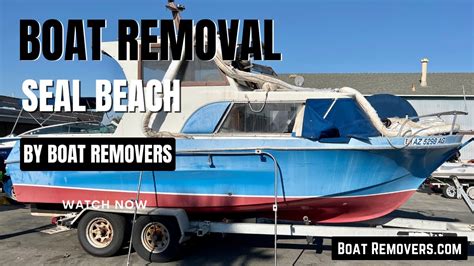Fiberglass Boat Removal: Your All-In-One Guide
Removing a fiberglass boat, whether it's a small dinghy or a larger vessel, can be a complex undertaking. This comprehensive guide will walk you through the entire process, from initial assessment to final disposal, ensuring a safe and efficient removal. Whether you're dealing with a derelict boat, an unwanted asset, or a boat damaged beyond repair, understanding the steps involved is crucial.
Assessing the Situation: The First Step in Fiberglass Boat Removal
Before you even think about touching the boat, a thorough assessment is paramount. This involves several key considerations:
- Boat Size and Condition: The size and condition of the boat significantly impact the removal process. A small, undamaged boat will require a different approach than a large, derelict vessel potentially containing hazardous materials.
- Location: Where is the boat located? Is it on land, in the water, or partially submerged? Access to the boat plays a critical role in determining the removal method. Consider factors like surrounding obstacles, terrain, and proximity to utilities.
- Environmental Concerns: Fiberglass boats, while durable, can contain hazardous materials like lead-based paint, asbestos, or fuel residues. Identifying and addressing these potential environmental hazards is crucial for a responsible removal.
- Legal Requirements: Check with your local authorities regarding permits, regulations, and disposal requirements for boat removal. Failure to comply with regulations can result in hefty fines.
What are the common challenges faced during fiberglass boat removal?
This is often the biggest hurdle for many boat owners looking to dispose of their vessels. Common challenges include:
- Weight and Size: Fiberglass boats can be surprisingly heavy and cumbersome, requiring specialized equipment for safe and efficient movement.
- Accessibility: Reaching the boat, especially if it's in a difficult-to-access location, can significantly increase the complexity and cost of removal.
- Environmental Regulations: Navigating the legal and environmental requirements for boat disposal can be time-consuming and frustrating.
- Cost: The cost of fiberglass boat removal can vary significantly depending on the factors mentioned above.
Choosing the Right Removal Method: Options for Fiberglass Boat Removal
Several methods exist for fiberglass boat removal, each suited to different situations:
-
DIY Removal (Small Boats): For smaller, lightweight boats in accessible locations, DIY removal might be feasible. This often involves dismantling the boat into smaller, manageable pieces for easier transportation and disposal. However, this approach demands careful planning and adherence to safety regulations.
-
Professional Removal (Large or Damaged Boats): For larger or damaged boats, or those located in challenging environments, professional removal services are highly recommended. These services possess the necessary equipment, expertise, and permits to handle complex removal projects safely and efficiently.
-
Specialized Recycling Facilities: Some facilities specialize in recycling fiberglass boats. These facilities can often recover usable materials, minimizing environmental impact.
How do I find a reputable fiberglass boat removal service?
Research is vital. Seek recommendations, check online reviews, and verify licensing and insurance. A reputable service will provide a detailed quote outlining the scope of work, costs, and timelines.
Preparing for Removal: Steps to Ensure a Smooth Process
Regardless of the chosen method, proper preparation is key:
- De-fueling and Cleaning: Empty all fuel tanks and remove any hazardous materials (oil, batteries, etc.) Properly dispose of these materials according to local regulations. Cleaning the boat will simplify handling and reduce environmental impact.
- Disassembly (If Applicable): If you're undertaking DIY removal, disassemble the boat into smaller, more manageable sections. Remember safety first and use appropriate tools.
- Transportation: Secure transportation is crucial. Use a trailer, flatbed truck, or other appropriate vehicle based on the size and weight of the boat or its parts.
Disposal and Recycling Options: Environmentally Responsible Choices
Responsible disposal is the final, crucial step. Options include:
- Landfill Disposal: Check local regulations; landfills may have restrictions on accepting fiberglass boats.
- Recycling: Seek out facilities that specialize in recycling fiberglass materials, contributing to sustainable practices.
- Donation: If the boat is in usable condition, consider donating it to a marine charity or educational institution.
What are the environmental implications of improper fiberglass boat disposal?
Improper disposal contributes to landfill overcrowding and potential environmental contamination from hazardous materials contained within the boat. Recycling or responsible disposal minimizes this impact.
Conclusion: A Safe and Responsible Fiberglass Boat Removal
Removing a fiberglass boat requires careful planning and execution. By following the steps outlined in this guide, you can ensure a safe, efficient, and environmentally responsible removal process, regardless of the boat's size, condition, or location. Remember that safety and compliance with regulations are paramount throughout the entire process.

